
Winthrop Technologies Limited (WTL) is a unique provider of turnkey data centre delivery services to our partners in the technology and cloud services sector. WTL views Gender Pay Gap Reporting as a positive initiative, as it will serve as an ongoing barometer against which we can measure our progress into the future.
Gender Pay Gap legislation requires employers with 250 or more employees to publish statutory calculations every year showing the difference between the average earnings of men and women within our business.
It is important to note that the gender pay gap is different to equal pay. The gender pay gap shows the difference in average pay between men and women. Equal pay requires that adults, regardless of gender, who carry out the same or similar jobs; or work of equal value, are paid the same.
WTL is strongly committed to equal pay for the same or similar jobs. We have processes in place to ensure there is equal pay for the same or similar work and operate our business and compensation policy according to strictly meritocratic principles.
WTL is similarly committed to the creation of an inclusive workplace where everyone can achieve their maximum potential. Promoting and supporting diversity and inclusion allows us to learn and grow from the understanding of different backgrounds and perspectives and to generate improved outcomes for our clients and our people.
The organisation is led by Anne Dooley (CEO) and Bernard Keane (Managing Director) both of whom have contributed enormously to the growth and success of the organisation over their years with the company.
This Gender Pay Gap Report is based on data as of 1st June 2023 for the WTL Irish workforce
.
Gender Balance
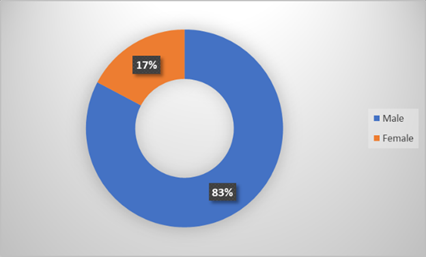
The percentage of the workforce accounted for by male and female employees
This Gender Balance report for 2023 represents a positive development versus the previous year with the proportion of females in the organization increasing from 13% to 17%.
This reflects a degree of success in ongoing initiatives towards increasing the number of females in the sector and the organization.
.
Gender Pay Gap
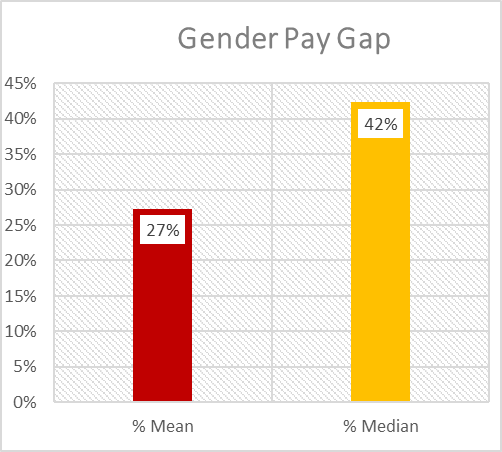
The gender pay gap represents the difference in average pay between men and women calculated according to the mean and median averages..
The Figures set out below have been calculated using the standard methodologies used in the Gender Pay Gap Information Act 2021 and all pertain to the 12-month period to 1st June 2023.
The gender pay gap figures reported here are largely in line with the prior year figures. There were minor increases in the gap arising largely from the addition of significant female headcount in the graduate and administrative areas when compared to the prior year.
% Receiving a Bonus & Gender Pay Gap for Bonus
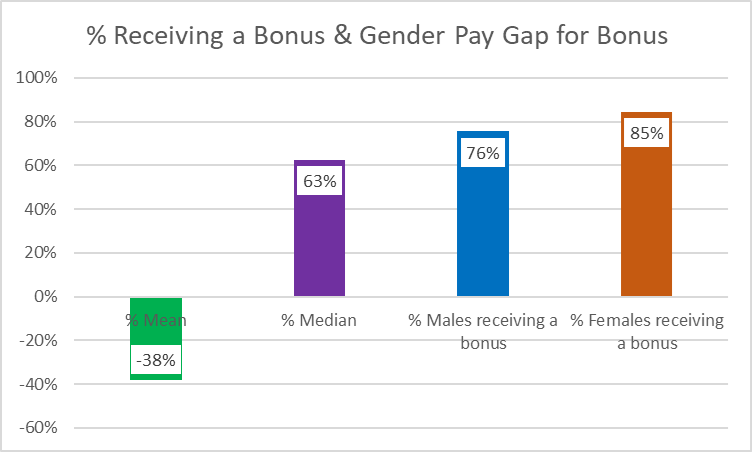
Percentage of male and female employees receiving a bonus compared to the median and mean figures.
The mean average bonus paid to females in the 12-month period was 38% higher than the mean average paid to males. This was a function of some significant bonuses being paid across several senior female staff. These bonuses were then averaged across a smaller number of total individuals than was the case for similar bonuses paid to senior male staff which was averaged across a higher number of individuals than the female comparison.
The mean average bonus comparison to the median average may not be intuitive at first glance. The median average represents the mid-point of all bonuses paid to individuals of either gender. Therefore, in a population with a significantly higher proportion of males and a high percentage of both genders receiving bonuses, it is to be expected that the mid-point of the higher number of individuals will be a higher figure.
% Receiving BIK
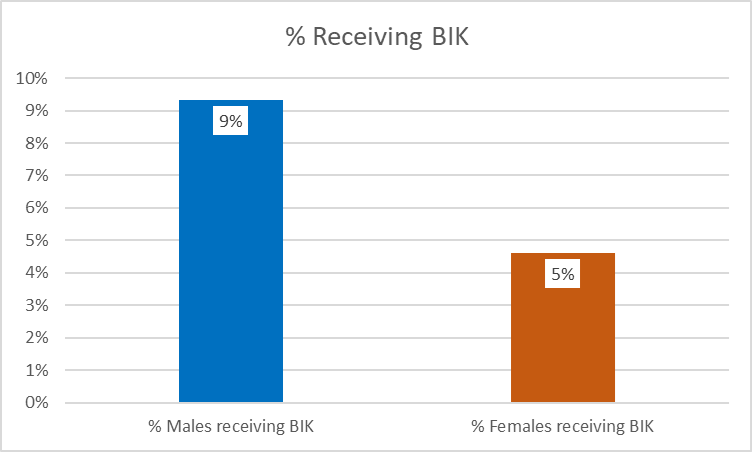
Percentage of male and female employees receiving Benefit-in-Kind from Winthrop.
Benefit-in-Kind does not form a significant part of the standard compensation package in Winthrop. As a result, a relatively low number of individuals of either gender are in receipt of BIK. The figures were largely in line with the previous year.
Upper pay quartile
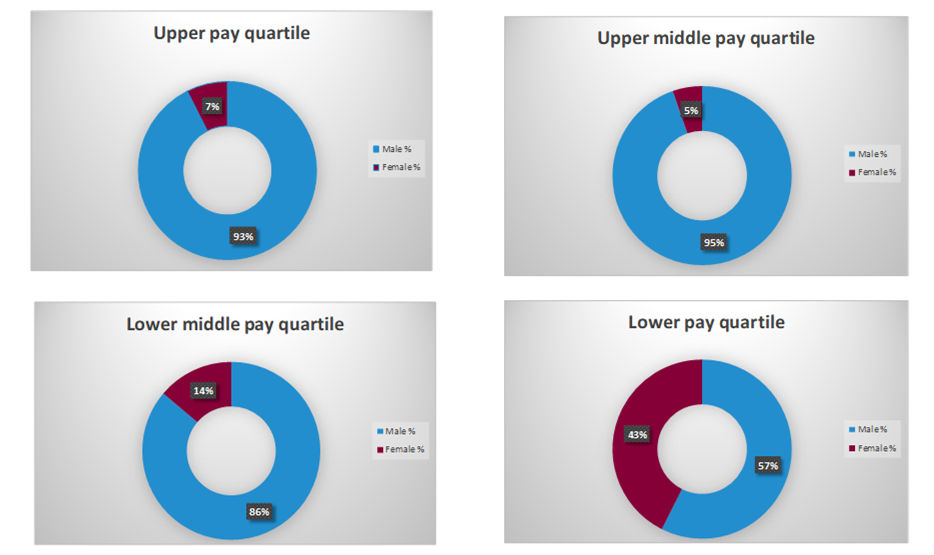
Each chart shows the division of male and female employees in each pay quartile.
While we continue to focus on attracting a growing number of females to the organization, it is encouraging to note that the percentage of females in the business increased year-on-year from 13% last year to 17% this year.
Similarly, it is encouraging that there was a 1% increase in the proportion of females in the upper pay quartile when compared to last year and a 2% increase in the proportion of females in the lower middle pay quartile.
The increase of 12% females in the lower pay quartile is illustrative of the success achieved in the efforts to attract more females to the sector and the organisation through the graduate programme. This will hopefully position Winthrop to further grow its female workforce going forward.
Although our CEO and several other senior management positions are currently held by females, it remains an objective of the organization to see this develop further in the coming years via the attraction of more females to the sector and the progression of more current female employees in the company
.
Influencing our data
The gender pay gap calculation reflects the position at a point in time. Analysis shows that the representation of males in senior roles contributes to the gap. The relatively low number of females in the sector traditionally, while changing, contributes to the current gap with a higher number of males in senior positions or with longer tenure.
Glossary of terms
Mean – the mean average is the total of all payments divided by the total number of employees. The difference between the mean hourly remuneration of relevant employees of the male gender and relevant employees of the female gender is expressed as a % of the mean hourly remuneration of relevant employees of the male gender – as below:
(A-B)/A x 100
Where:
A is the mean hourly remuneration of all relevant employees of the male gender
B is the mean hourly remuneration of all relevant employees of the female gender
Median – the median average is the midpoint of the relevant set of data. Rank all male employees according to hourly remuneration. Count the number of individuals and identify the individual at the mid-point, identify the hourly remuneration of this individual – this is the median. The difference between the median hourly remuneration of relevant employees of the male gender and that of relevant employees of the female gender is expressed as a percentage of the mean hourly remuneration of relevant employees of the male gender – as below:
(A-B)/A x 100
Where:
A is the median hourly remuneration of all relevant employees of the male gender; and B is the median hourly remuneration of all relevant employees of the female gender.
% of (fe)males receiving a bonus / BIK – the % of (fe)males in employment as of 1 June 2023 that received a bonus / BIK payment in the prior 12 month period
Pay Quartile – All individuals in employment as of 1 June 2023 were ranked according to hourly remuneration, lowest to highest paid. The employees were then then divided into four groups each comprising an equal number of employees, thereby determining the group that earned the most on average and so on. The headcount of each group was then broken out between females and males and the % of each gender in each group calculated.

